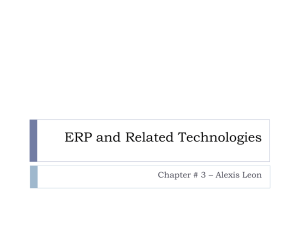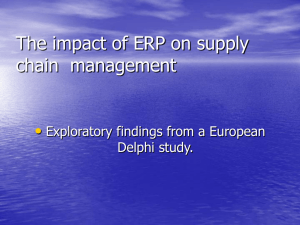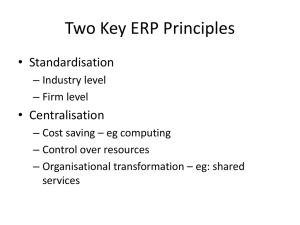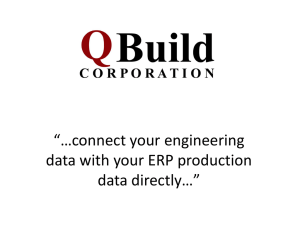Enhancing Business Processes Using Enterprise Information Systems
advertisement
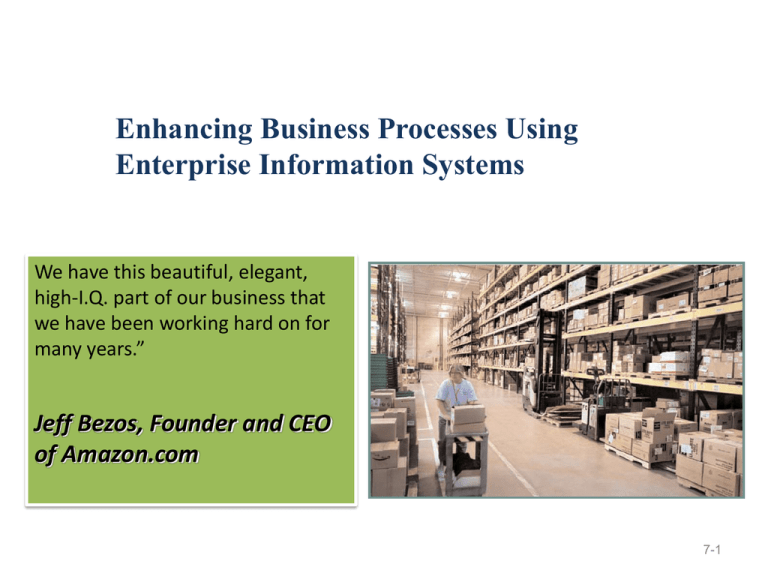
Enhancing Business Processes Using Enterprise Information Systems We have this beautiful, elegant, high-I.Q. part of our business that we have been working hard on for many years.” Jeff Bezos, Founder and CEO of Amazon.com 7-1 Review Questions 1. 2. 3. 4. 5. 6. What is Web 2.0? Describe Tagging? What are the main types of e-commerce? Describe an extranet/intranet? List the e-commerce business strategies. What is the long tail? Review Questions 7. What is an information system (IS)? 8. What are the levels of a firm and who serves them? 9. What information systems serve each level of a firm? 10. What are the functional areas of a business? 11. What are the major roles of IS? Learning Objectives 7-4 1. Explain core business processes that are common in organizations. 2. Describe what enterprise systems are and how they have evolved. 3. Describe enterprise resource planning systems and how they help to improve internal business processes. 4. Understand and utilize the keys to successfully implementing enterprise systems. Learning Objectives 7-5 1. Explain core business processes that are common in organizations. 2. Describe what enterprise systems are and how they have evolved. 3. Describe enterprise resource planning systems and how they help to improve internal business processes. 4. Understand and utilize the keys to successfully implementing enterprise systems. Core Business Processes • Traditional business functions: – – – – Marketing and sales Supply chain management Accounting and finance Human resources • Not distinct independent silos, but instead highly interrelated • Business processes cross boundaries of business functions. 7-6 Order-to-Cash Process • The processes associated with selling a product or service 7-7 Procure-to-Pay Process • The processes associated with procuring goods from external vendors 7-8 Make-to-Stock / Make-to-Order Process • The processes associated with producing goods 7-9 Supply Chain • Core business processes enable the creation of supply chains. • Resembles a river – Start at source – Move downstream 7-10 Value Chain • Value Chain—The set of business activities that add value to the end product. • Information flows through a set of business activities. – Core activities—functional areas that process inputs and produce outputs. – Support activities—enable core activities to take place. 7-11 Value Chain Framework 7-12 Core Activities • Inbound logistics activities – Receiving and stocking raw materials, parts, and products – Amazon.com—receipt of books, e-book readers, other products, packaging materials, shipping labels • Operations and manufacturing activities – Order processing and/or manufacturing of end products – Dell—component parts assembled to make products • Outbound logistics activities – Distribution of end products – Amazon.com—delivery of books to customers 7-13 Core Activities (cont’d) • Marketing and Sales activities – Presale marketing activities (e.g., creating marketing literature) – United—use of IS to update prices and schedules • Customer service activities – Post-sale activities – Amazon.com—customers can view their order status or can view and print invoices of current and past orders 7-14 Support Activities • Administrative activities • Support of day-to-day operations (for all functional areas) • Infrastructure activities • Implement hardware and software needed • Human resource activities • Employee management (interviews, hiring, payroll, benefits) • Technology development activities • Design and development of applications to support the primary activities • Procurement activities • Purchasing of goods and services (inputs into the primary activities) 7-15 Externally Focused Applications—Value System • Coordination of organizational value chains • Information Flows in a Value System – Upstream information flow—information received from another company – Downstream information flow—information produced by a company and sent to another organization 7-16 Learning Objectives 7-17 1. Explain core business processes that are common in organizations. 2. Describe what enterprise systems are and how they have evolved. 3. Describe enterprise resource planning systems and how they help to improve internal business processes. 4. Understand and utilize the keys to successfully implementing enterprise systems. The Rise of Enterprise Systems • Stand-alone applications – Not designed to communicate with other system – Variety of computing hardware platforms – Enable departments to conduct daily business activities – Not helpful for other areas in the firm • Proprietary systems – From vendors – Not designed to share with other vendors’ systems – Problem of knitting together (hodgepodge portfolio of discordant proprietary applications) – Lack of integration 7-18 Legacy Systems • Each department has its own system. Infrastructure specific Inefficient processes Potential for inaccuracies Too many “rocks in the river” 7-19 Enterprise System Approach • Integrated suite of business applications for virtually every department, process, and industry 7-20 Supporting Business Processes • Internally focused systems – Support functional areas, business processes, and decision making within an organization – New information (value) is added at every step. 7-21 Supporting Business Processes • Externally focused systems (interorganizational systems) – Coordinate business activities with customers, suppliers, business partners, and others who operate outside the organization – Streamline the flow of information between companies 7-22 The Need for Integrated Enterprise Systems • Advantages of integrated systems – Centralized point of access • Conversion of information from legacy systems needed • Enterprise Resource Planning (ERP) vendors offer different modules. – Components that can be selectively implemented – Example: Modules of mySAP business suite 7-23 Improving Business Processes Through Enterprise Systems • Packaged software – – – – – Written by third-party vendors Used by many different organizations Useful for standardized, repetitive tasks Cost effective Example: Microsoft Office • Custom software – Developed exclusively for a specific organization – Designed for particular business needs – Higher development costs 7-24 Modules of Enterprise Systems • Each module in an enterprise system replaces a stand-alone legacy system. 7-25 Vanilla Versus Customized Software • Vanilla version – This version contains features and modules that an enterprise system comes with out of the box. – Certain processes might not be supported. • Customization – This version contains additional software or changes to vanilla version. – It always needs to be updated with new versions of vanilla. 7-26 Capabilities of SAP’s ERP System 7-27 Best Practices-Based Software • Most ERP vendors build best practices into their ERP systems. – Identify business processes in need of change – Future updates are smoother if businesses change their business processes to fit with ERP systems. • Is following the best practices always the best strategy? – If companies have competitive advantage from unique business processes, forcing best practices may actually hurt. 7-28 Business Process Management (BPM) • Systematic and structured improvement approach – All or part of organization is involved. – Rethinking and redesign of business processes • • • • Became popular in 1990s IS seen as key enabler for radical change Processes intended to be cross-functional Various related terms: 7-29 BPM Steps 1. Develop a vision for the organization (specify business objectives). 2. Identify critical processes that are to be redesigned. 3. Understand and measure existing processes as a baseline. 4. Identify ways IS can be used for improvement. 5. Design and implement a prototype of the new processes. 7-30 Conditions Leading to a Successful BPM • • • • • • • Support by senior management Shared vision by all organizational members Realistic expectations Participants empowered to make changes The right people participating Sound management practices Appropriate funding 7-31 Learning Objectives 7-32 1. Explain core business processes that are common in organizations. 2. Describe what enterprise systems are and how they have evolved. 3. Describe enterprise resource planning systems and how they help to improve internal business processes. 4. Understand and utilize the keys to successfully implementing enterprise systems. Enterprise Resource Planning (ERP) Systems • Enterprise Resource Planning—Applications that integrate business activities across departmental boundaries. • ERP evolved during the 1990s from material/manufacturing requirements planning packages. • Emphasis has since shifted from “resources” and “planning” to “enterprise.” • Integrate legacy information on a company-wide basis 7-33 Integrating Data to Integrate Applications • Central information repository – ERP replaces standalone applications – Modules based on • Common database • Similar application interfaces 7-34 Example ERP Screen • An ERP system can provide employees with relevant, up-to-date information. 7-35 Core and Extended ERP Components • Core components—support primary internal activities. • Extended components—support primary external activities. 7-36 ERP Core Components • Financial Management – accounting, financial reporting, performance management, corporate governance • Operations Management – simplify, standardize, and automate business processes for inbound/outbound logistics, product development, manufacturing, sales and service • Human Resource Management – employee recruitment, assignment tracking, performance reviews, payroll, regulatory requirements 7-37 Human Resources Management 7-38 Order-to-Cash 7-39 Procure-to-Pay 7-40 Production 7-41 ERP Installation • Configuration of the ERP systems is performed during any ERP implementation. • System must be configured to reflect business processes and associated business rules. • Organizations have to make countless decisions on how to configure thousands of database tables to fit the business’s needs. • Organizations hire experienced business analysts or outside consultants to assist with implementation. 7-42 ERP Limitations • ERP falls short in communicating across organizational boundaries. • They tend to be not well suited for managing value system activities. • Other systems can work with ERP to provide these capabilities. 7-43 Learning Objectives 7-44 1. Explain core business processes that are common in organizations. 2. Describe what enterprise systems are and how they have evolved. 3. Describe enterprise resource planning systems and how they help to improve internal business processes. 4. Understand and utilize the keys to successfully implementing enterprise systems. The Formula for Enterprise System Success 1. Secure executive sponsorship . – 2. Get help from outside experts. – – 3. – Training is the most overlooked, underestimated, and poorly budgeted expense. Training can prevent dissatisfaction. Take a multidisciplinary approach to implementations. – 5. Consultants are specifically trained. Implementation tends to happen faster. Thoroughly train users. – 4. Most failures are due to lack of top-level management support. Include end users from all functional areas in the implementation. Initiate evolving the ERP Architecture. 7-45 Evolving the ERP Architecture 7-46 ERP systems are difficult to install, maintain, and upgrade. Service-oriented architecture (SOA) Business processes are broken down into services. Services are designed to achieve desired results for service consumer. Example: Oil change SOA approach enables businesses to react more swiftly to changing needs. Three principles of services Reusability Interoperability Componentization ERP vendors are offering products for transitioning to SOA. Service-Oriented Architecture (SOA) 7-47 Multiple applications can access multiple services. Extra Content END OF CHAPTER CONTENT 7-48 Managing in the Digital World: Amazon.com 2009 sales topped $24 billion, with 836 million users Innovations leading to satisfaction Excellent at managing entire supply chain Both acquiring the right products at the right time and shipping the products to the customers are crucial. Amazon has 12 North American and 7 international fulfillment centers Amazon.com manages fulfillment for Target.com as well as other businesses. Independent retailers can use Amazon.com’s supply chain infrastructure on an as-needed basis. 7-49 Complexity of Modern Manufacturing: Toyota Automobiles • Complexity of modern manufacturing – Automobiles are sophisticated and complex (GPS, Internet, entertainment, fuel injection, safety, ABS) – Toyota Prius ABS software bug (2009–2010) recalled 40,000 cars – Use of IS for supply chain management is vital for building modern automobiles – Complexity is likely to grow over time 7-50 ETHICAL DILEMMA Too Much Intelligence? RFID and Privacy • Radio frequency identification (RFID) tags are the latest in technological tracking devices . • Privacy advocates are concerned about misuse. • Someone with an RFID reader can possibly identify where you bought the product and how much you paid for it. • The state of Washington passed a law in 2009 that prohibits anyone from scanning an RFID tag, except the business owner or agency who issued the tag. 7-51 NET STATS The Changing Value of Social Media in the Workplace • Facebook, LinkedIn, and Twitter are increasingly used for connecting, sharing, and collaborating with customers and suppliers. • Major trends: – Social media is increasingly being used for improving decision making. – Social media goes beyond networking (intelligence, service). – Best practices communities are emerging, easing the search for key human resources. – Personnel are attracted to organizations that embrace social media. – Personnel place strong value on organizations demonstrating transparency and responsiveness to social media. 7-52 COMING ATTRACTIONS Power of the Swarm • Swarm intelligence – Ants, bees, termites, and wasps have powerful collective problem-solving skills. – Ants use pheromone trails to mark routes; more ants means stronger pheromones leading to more use of a route. – AI systems can use swarm intelligence techniques for • • • • Military surveillance and monitoring Health Micro-manufacturing Space exploration – Self-replicating agents/robots 7-53 POWERFUL PARTNERSHIPS SAP—Dietmar Hopp, Hans-Werner Hector, Hasso Plattner, Klaus Tschira, and Claus Wellenreuther • Former IBM employees • 80’s—multiple international subsidiaries • Largest software company – 39,300 people – Third largest in terms of revenue • Includes: – – – – – ERP CRM PLM SCM SRM 7-54



